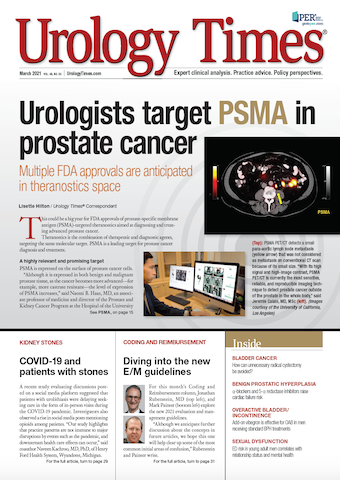Publication
Article
Urology Times Journal
E/M guidelines require a different approach to documentation
Author(s):
Providers must carefully outline their clinical thought process.
Jonathan Rubenstein, MD

We have received a number of questions from those seeking advice on choosing a coding level when using the new 2021 evaluation and management (E/M) guidelines. The most common questions concern the meaning and interpretation of ideas within the 3 medical decision–making (MDM) categories: the complexity of presenting problem, data, and risk. We are dedicating this article to explaining some of the nuances of the new guidelines, giving our thoughts on the interpretation of many of the ideas. We also aim to advise how best to incorporate these concepts into the practice of medicine and improve chart documentation. Although we anticipate further discussion about the concepts in future articles, we hope this one will help clear up some of the most common initial areas of confusion. There may still be some adjustments to the interpretation from the American Medical Association (AMA) or the Centers for Medicare & Medicaid Services (CMS), as even they continue to answer thousands of questions. We will not be addressing time-based coding in this article.
Number and complexity of problem(s) addressed at patient encounter
Mark Painter

In the 1997 E/M guidelines, the presenting problems section allowed a provider to add up points based upon the evaluation and management of new or established problems that were stable, worsening, or required further evaluation at the time of the patient visit; the sum of the points determined the final level for this section. In contrast, the level selected for this section in the 2021 E/M guidelines is no longer additive, but is now based upon the patient being seen for problems that are self-limited; acute or chronic; or stable, stable or worsening, or life threatening; or for one that is as yet undiagnosed and has an uncertain prognosis.The reason for this update is to compensate the health care professional for their thought process when evaluating a patient, and for their expertise with MDM regarding a patient’s treatment during an episode of care. Due to this update, providers will need to adjust their thinking and how they approach the problem(s) addressed section.
The part of this section that requires the greatest change is when providers address a new problem. In the updated guidelines, there is no specific category for new problem. Rather, if a diagnosis is made and it is acute or chronic, that is the level that should be chosen. The only term that specifically addressed new problem is that of “undiagnosed new problem with uncertain prognosis.” Providers should not choose this for all new problems, but rather only for new problems that are undiagnosed and require further evaluation with a differential diagnosis that includes a high risk of morbidity without treatment. Urology examples include patients who present with an elevated prostate-specific antigen (PSA) level, an abnormal prostate examination or prostate nodule, gross or microscopic hematuria, or a new onset flank pain for which a diagnosis cannot be made while they are in the office. The differential diagnosis in each of these examples includes diagnoses with a high risk of morbidity without treatment, such as underlying cancer. In contrast, examples that do not qualify may include patients who present with acute cystitis, a known ureter stone, or epididymitis, which, while may be new to the examiner, are either diagnosed at the time of the office visit or do not have a high risk of morbidity.
It is important to provide accurate documentation to support one’s thought process, in a way that gives a coder or auditor enough information to ensure that a chart is coded appropriately. Auditors may not be trained specifically in urology and therefore may not understand the implications of the provider’s thought process, so providing appropriate documentation will reduce the risk of an adverse audit. For patients who present with an undiagnosed new problem with uncertain prognosis, documentation should include the knowns and unknowns about the condition. This includes the potential next clinical step(s) for work-up to establish a diagnosis and the potential for morbidity of the diagnoses that may be found. Examples include the following:
Gross hematuria. Gross hematuria may be due to both benign and malignant conditions, and the differential diagnosis includes trauma, infections, organ bleeding, and cancers. When a patient presents with gross hematuria, the next step in management depends on the patient’s history and circumstances. Therefore, documentation should support the provider’s thought process and the risks, and may include statements such as: “Gross hematuria (known) of unknown etiology (unknown): Plan is to schedule the patient for upper tract imaging and then to perform a cystoscopy to rule out kidney or bladder cancer (potential).”
Elevated PSA. Similarly, a patient who presents with an elevated PSA could have both benign and malignant conditions and the differential diagnosis include prostate enlargement, infections, and prostate cancer. The initial evaluation for a patient with an elevated PSA may therefore qualify as an undiagnosed new problem with uncertain prognosis. Documentation to support this may include a statement such as: “The patient presents for an evaluation of a new finding of an elevated PSA as referred from their primary care provider (known). The most recent PSA is up to 5.5 ng/mL from about 2.0 in the past. The prostate exam today reveals no concerning nodules. I explained to the patient that this increase in PSA could indicate multiple problems (unknown) including prostate cancer or prostatitis (potential). After discussion, he agreed to try an antibiotic for 2 weeks and to recheck the PSA to rule out prostatitis as the cause of the PSA elevation. He will return after his repeat PSA, and if the level remains elevated we may need to proceed to a prostate biopsy. The patient will call if he experiences any progressing symptoms in the interim.”
Amount and/or complexity of data to be reviewed and analyzed
The data portion of MDM has generated a number of questions for us as well as the AMA, and requires clarification. A deeper dive into the guidelines offers further insight into the interpretation and proper use of items in this MDM category. Remember, data previously reported or ordered by the physician that are now reviewed cannot be counted a second time as data under MDM for a subsequent visit. Providers should remember that “independent interpretation of test performed by another physician/other qualified health care professional” requires more in documentation than simply stating that an outside image was reviewed. Rather, documentation must include the work performed, the independent interpretation of the data, and findings; these include abnormalities, if any, and relevant normal findings. Once again, the key to a successful chart is appropriate supporting documentation.
Risk of complications and/or morbidity or mortality of patient treatment
The risk category in the 2021 E/M guidelines was based upon the table of risk in the 1997 guidelines using the diagnostic procedure(s) ordered and management option(s) selected. Therefore, of the 3 MDM sections, the risk category is the one least changed and most familiar to providers. Once again, documentation of one’s thought process is paramount to accurate code selection and protection from an audit.
The AMA Current Procedural Terminology (CPT) guidelines define risk as: “the probability and/or consequences of an event. The assessment of the level of risk is affected by the nature of the event under consideration. For example, a low probability of death may be high risk, whereas a high chance of a minor, self-limited adverse effect of treatment may be low risk. Definitions of risk are based upon the usual behavior and thought processes of a physician or other qualified health care professional in the same specialty. Trained clinicians apply common language usage meanings to terms such as ‘high’, ‘medium’, ‘low’, or ‘minimal’ risk and do not require quantification for these definitions, (though quantification may be provided when evidence-based medicine has established probabilities). For the purposes of MDM, level of risk is based upon consequences of the problem(s) addressed at the encounter when appropriately treated. Risk also includes MDM related to the need to initiate or forego further testing, treatment and/or hospitalization.”
We would like to use an example that is common in urology to help highlight some thoughts when using risk: active surveillance for prostate cancer. A number of providers and coders have suggested that 99212 would be the appropriate code to use for all patients on active surveillance using the new E/M guidelines, as the patient would be coded using a level 3 presenting problem (1 stable chronic condition), level 2 for data (PSA), and straightforward risk (venipuncture). Although this conclusion may be correct for some cases, it is not correct for all, based upon the CPT definition of risk.
The table in the guidelines for risk provides risk examples; however, by itself, it is not intended to encompass the entirety of the guidelines but rather to provide a quick reference. When one considers the consequences of MDM for patients on active surveillance for prostate cancer, their risk may vary based upon other factors, such as age, family history, other signs and symptoms, pathology report, test results, and other health conditions. The provider must also consider the available treatment options and the risks associated with either intervention or continued monitoring of the patient. For some patients, the problem may be considered minimal, while others may be at a higher risk of progression or have a higher risk based upon their ability to tolerate a treatment. Although many patients on surveillance have straightforward risk, this is not the case with everyone. Using key words such as minimal, low, moderate, and high where appropriate in the documentation explains one’s thinking and helps in the communication with an auditor. Documenting in a way that shows a level of risk that other urologists would agree upon given the same situation may support a risk level.
In short, from an auditing perspective, a chart review is based on the information documented. If the patient’s full condition and diagnostic considerations are not well documented, it would require another urologist or someone with a deep clinical understanding of the conditions treated to interpret the true nature of the visit. Payers and the vast majority of coders will not take that step. Instead of leaving this interpretation to chance, we encourage clearly worded documentation to help support the selected risk level. This would protect one’s code choice in the event of chart reviews by insurers and help support appeals in the event of denials.
Conclusions
We recognize there may be areas of confusion when trying to understand the new 2021 E/M guidelines. For accurate code selection, providers must comprehend the true intent of the words in the guidelines at a deep level and also document the chart to support their thought process. There remains some ambiguity concerning the definitions, likely created by design due to medical care being individualized and based upon patient presentation and how a similar provider faced with the same situation might act. E/M coding cannot always be based on a single diagnosis or even a group of diagnoses. Instead, it must be based on the documentation of the patient presentation and the provider’s clinical thought process on the date of the visit. This deeper understanding of the guidelines should provide an opportunity for practices to reset their operational thinking so that the work, effort, and risk of a patient’s condition at their medical encounter is appropriately documented and therefore appropriately billed.
Rubenstein is compliance officer and medical director of coding and reimbursement, United Urology Group and Chesapeake Urology, Towson, Maryland. Painter is CEO of PRS Urology SC in Denver, Colorado.
The information in this column is designed to be authoritative, and every effort has been made to ensure its accuracy at the time it was written. However, readers are encouraged to check with their individual carrier or private payers for updates and to confirm that this information conforms to their specific rules.



























